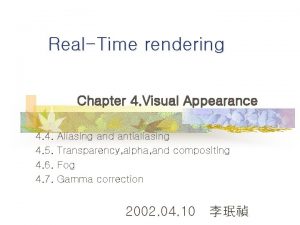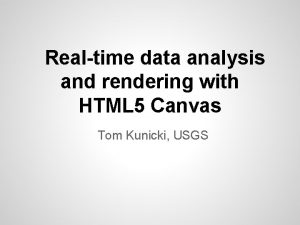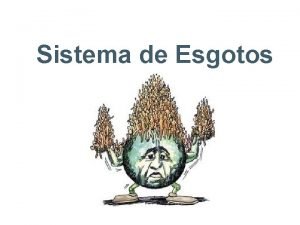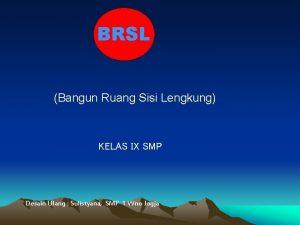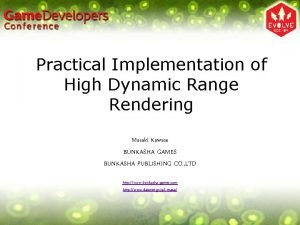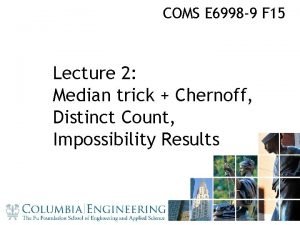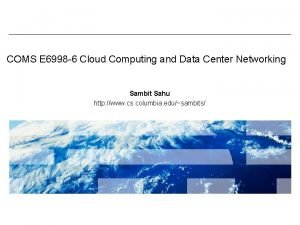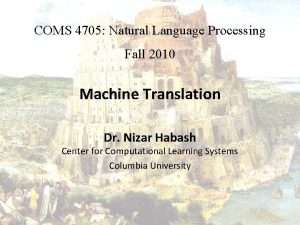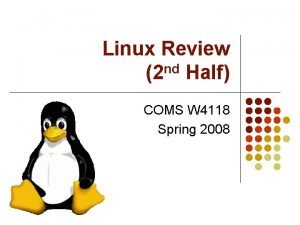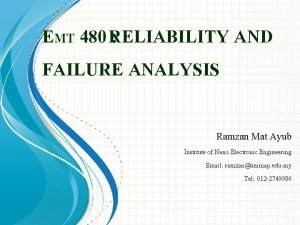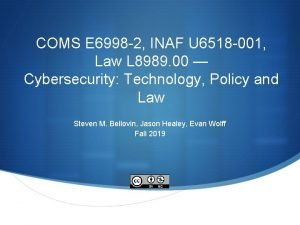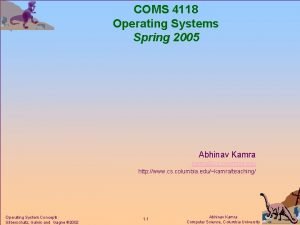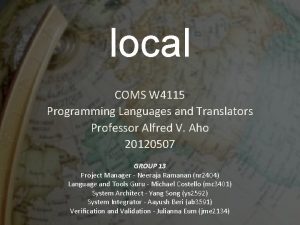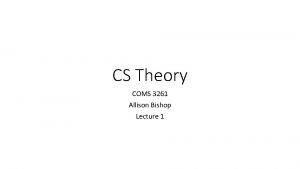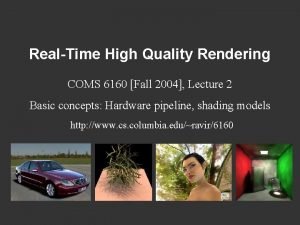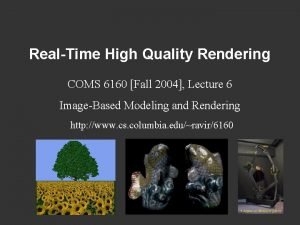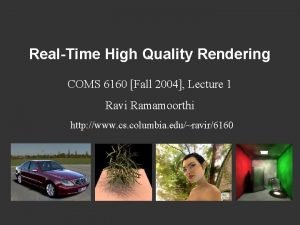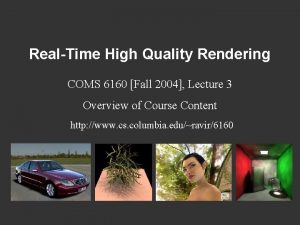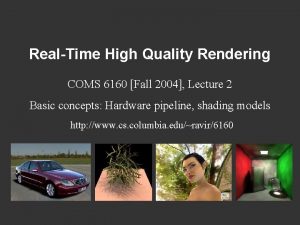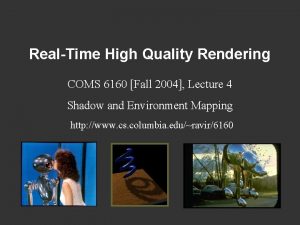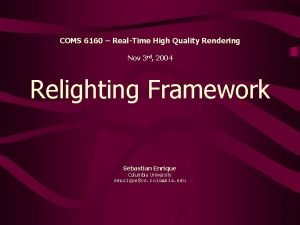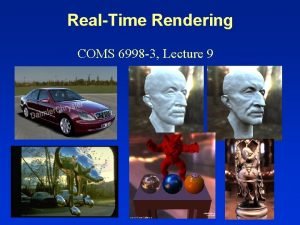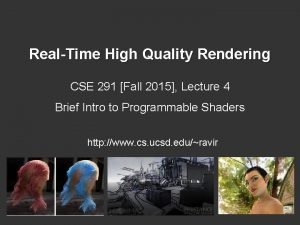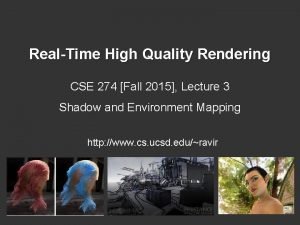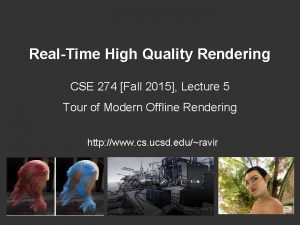RealTime High Quality Rendering COMS 6160 Fall 2004
![Real-Time High Quality Rendering COMS 6160 [Fall 2004], Lecture 3 Overview of Course Content Real-Time High Quality Rendering COMS 6160 [Fall 2004], Lecture 3 Overview of Course Content](https://slidetodoc.com/presentation_image_h2/c8e8de86581af3ced5c74c75e8c246a4/image-1.jpg)












- Slides: 13
![RealTime High Quality Rendering COMS 6160 Fall 2004 Lecture 3 Overview of Course Content Real-Time High Quality Rendering COMS 6160 [Fall 2004], Lecture 3 Overview of Course Content](https://slidetodoc.com/presentation_image_h2/c8e8de86581af3ced5c74c75e8c246a4/image-1.jpg)
Real-Time High Quality Rendering COMS 6160 [Fall 2004], Lecture 3 Overview of Course Content http: //www. cs. columbia. edu/~ravir/6160

To Do § By tomorrow midnight, e-mail me ordered list of (at least) 4 papers for presentation § Papers will be assigned on a first-come first-served basis § If you don’t respond, you will be assigned and have to do papers randomly (including possibly next week) § Start thinking about your projects (for those on grades). Project descriptions required in 2 weeks. A good idea is to choose to present papers relating to your intended project. § This brief lecture previews the papers/topics in the course

3 basic themes § (Programmable) graphics hardware § Precomputation-based methods § Interactive ray-tracing/global illumination § Some overlap between these (e. g. algorithmic improvements based on precomputation, followed by hardware rendering)

Outline of papers/topics covered § Graphics hardware § Classic papers (today) § Programmability/tricks for high-quality rendering (next) § General programmable shading systems (Sep 29) § Shadow mapping (lecture Oct 6, papers Oct 13) § Precomputation-based methods § General environment mapping (complex lighting) (Oct 20) § Factored BRDF representations (Oct 27) § General precomputation-based methods (Nov 3, 10) § Interactive ray-tracing/global illumination (Nov 17, Dec 1)

High Quality Hardware Shading (next) § Heidrich 99, one of first papers. Hardware tricks (before current programmable graphics; in standard Open. GL) § Purcell et al. 02, map ray tracing to standard programmable hardware scanline pipeline § Lindholm et al. 01, first n. Vidia vertex shaders (Ge. Force 3)

General Programmable Shading (29) § First programmable shading systems for hardware § Peercy et al. 00: Multipass Open. GL implementation of Render. Man (Open. GL as general SIMD machine) § Proudfoot et al. 01: Multiple computation frequencies (precursor to vertex, fragment shaders) § Mark et al. 03: Describes n. Vidia’s Cg: one of first commercial high-level shading languages for programmable hardware

Shadow Mapping (Oct 13) § Classic technique to add complex curved shadows § Williams 78, oldest paper we discuss in course § Many recent extensions for programmable hardware § Soft shadows: Agrawala 00 § Complex geometry like hair: Lokovic and Veach 00 § Adaptive techniques: Fernando 01, Stamminger 02, Sen 03

Outline of papers/topics covered § Graphics hardware § Classic papers (today) § Programmability/tricks for high-quality rendering (next) § General programmable shading systems (Sep 29) § Shadow mapping (lecture Oct 6, papers Oct 13) § Precomputation-based methods § General environment mapping (complex lighting) (Oct 20) § Factored BRDF representations (Oct 27) § General precomputation-based methods (Nov 3, 10) § Interactive ray-tracing/global illumination (Nov 17, Dec 1)

Complex Lighting, Materials (Oct 20) § Cabral et al. 99, first use of environment maps and general materials § Ramamoorthi 02, frequency domain approach (DEMO)

Factored Texture Maps (Oct 27) § Many high-dimensional functions (BRDFs, Light Fields) can be factored into lower-dimensional 2 D textures for hardware § Mccool 01, BRDFs § Latta 02, Environment maps with general materials § Chen et al. 02, Surface light fields

Precomputed Transfer (Nov 10, 17) § Precompute on static scenes, followed by real-time relighting, changing view. Can capture most complex shading effects. § Sloan et al. 02, 03: Low-frequency SH, compression § Ng et al. 03, 04: Wavelets all-frequency, relight, view change § Sloan 04, Wang 04: Factored BRDFs all-frequency relighting

Outline of papers/topics covered § Graphics hardware § Classic papers (today) § Programmability/tricks for high-quality rendering (next) § General programmable shading systems (Sep 29) § Shadow mapping (lecture Oct 6, papers Oct 13) § Precomputation-based methods § General environment mapping (complex lighting) (Oct 20) § Factored BRDF representations (Oct 27) § General precomputation-based methods (Nov 3, 10) § Interactive ray-tracing/global illumination (Nov 17, Dec 1)

Interactive Global Illumination § Eurographics STAR report reviews state of the art § Two recent papers § Tole et al. 02, dynamic scenes § Bala et al. 03, combining edges and points
